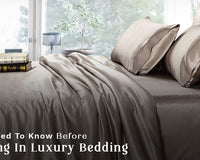Dealing with a bed bug infestation on your mattress can be a frustrating and unsettling experience. These nocturnal pests are notorious for causing discomfort and health issues. However, with the right approach, you can effectively eliminate them from your extra deep mattress protector and prevent future infestations. In this comprehensive guide, we will explore the various steps and methods to get rid of bed bugs in a mattress, ranging from identification to prevention.
How Do Bed Bugs Infest A Mattress?
Bed bugs are expert hitchhikers, often finding their way into our homes through luggage, used furniture, or even clothing. Once inside, they seek refuge in areas close to their host, making mattresses an ideal hiding spot. A mattress's folds, seams, and crevices provide a perfect environment for bed bugs to thrive, as they can easily access their human hosts during the night.
What Are The Common Signs Of Bed Bugs In A Mattress?
- Minor reddish-brown bugs: Adult bed bugs are approximately the size of an apple seed, making them visible to the naked eye.
- Tiny white eggs: Bed bug eggs are usually found in clusters and resemble small rice grains.
- Reddish-brown faecal stains: Bed bugs excrete dark stains that resemble rust on the mattress surface.
- Musty odour: An unpleasant, sweet, musty smell may indicate a bed bug infestation.
How To Confirm The Presence Of Bed Bugs?
- Visual inspection: Use a flashlight and magnifying glass to carefully inspect the mattress's seams, folds, and crevices.
- Bed bug traps: Place bed bug traps around the legs of the bed to capture any crawling bugs.
- Mattress encasements: Use specialised bed bug-proof mattress encasements to trap and identify bed bugs.
What Items Need To Be Removed Or Treated?
- Bedding and linens: Extra deep mattress fitted sheets and Mattress wash in hot water and dry on high heat to kill bed bugs and their eggs.
- Clothing: Launder all clothing worn in infested areas.
- Curtains: Clean or wash curtains thoroughly.
- Clutter: Declutter the bedroom to eliminate hiding spots for bed bugs.
-
Vacuum cleaner: Regularly clean and empty the vacuum to prevent bed bugs from escaping.

How To Thoroughly Inspect The Mattress For Bed Bugs?
- Remove bedding and linens: Strip the mattress of all bedding and linens.
- Examine seams and folds: Use a flashlight and magnifying glass to inspect seams, folds, and crevices.
- Check bed frame and headboard: Inspect the bed frame, headboard, and surrounding furniture for signs of bed bugs.
- Use a credit card: Run a credit card along seams to dislodge bed bugs hiding within.
What Are Some Natural Remedies For Eliminating Bed Bugs?
- Diatomaceous earth: Sprinkle a thin layer of food-grade diatomaceous earth on the mattress surface.
- Essential oils: Use tea tree, lavender, or eucalyptus to repel bed bugs.
- Baking soda: Sprinkle baking soda on the mattress and vacuum it after a few hours.
- Steam cleaning: Use a steam cleaner to kill bed bugs and their eggs on the mattress.
How To Safely Apply Chemical Treatments On A Mattress?
- Choose appropriate pesticides: Select bed bug pesticides designed explicitly for mattresses.
- Follow product instructions: Read and follow the manufacturer's instructions carefully.
- Apply in a well-ventilated area: Ensure proper ventilation when applying chemical treatments.
- Wear protective gear: Wear gloves and a mask during application.
What Cleaning Methods Are Suitable For A Bed Bug-Infested Mattress?
-
Hot water and high heat: Wash bedding and linens in hot water and dry on high heat.

- Vacuuming: Use a vacuum cleaner with a HEPA filter to remove bed bugs and eggs from the mattress surface.
- Freezing: Place infested items in sealed plastic bags and freeze them to kill bed bugs.
How To Properly Dispose Of A Mattress With Bed Bugs?
-
Wrap in plastic: Seal the mattress in plastic to prevent bed bugs from spreading during disposal.

- Label as infested: Mark the mattress to alert waste management personnel.
- Coordinate with local authorities: Check local regulations for proper disposal methods.
How To Prevent Future Bed Bug Infestations In The Mattress?
- Mattress encasements: Use bed bug-proof mattress encasements to prevent infestations.
- Regular cleaning: Vacuum the mattress regularly to eliminate potential hiding spots.
-
Avoid second-hand furniture: Refrain from using used furniture without a thorough inspection.

- Monitor frequently: Look for signs of bed bugs and promptly act if detected.
Conclusion
Dealing with bed bugs in a mattress requires a systematic approach, from identifying the signs to implementing effective eradication methods. By combining natural remedies, chemical treatments, and proper cleaning practices, you can reclaim your mattress and ensure a good night's sleep. Remember to stay vigilant and take preventive measures to avoid future bed bug infestations.
FAQs
Are there any specific areas prone to infestation?
Bed bugs can infest any area where humans frequent, but they are commonly found in bedrooms, especially in and around the bed. Other areas prone to infestation include couches, chairs, and areas with heavy foot traffic.
What signs indicate the need for professional pest control?
If DIY methods prove ineffective or the infestation is extensive, it's advisable to seek professional pest control services. Signs that may indicate the need for professional help include persistent infestations, increasing bed bug populations, and bed bugs in multiple rooms.
How to use heat or cold to kill bed bugs in a mattress?
Heat treatment involves exposing the mattress and infested items to high temperatures (120°F or higher) for an extended period. On the other hand, cold therapy involves freezing infested items at temperatures below 0°F for several days. Both methods kill bed bugs and their eggs effectively, but professional equipment may be required for optimal results.


